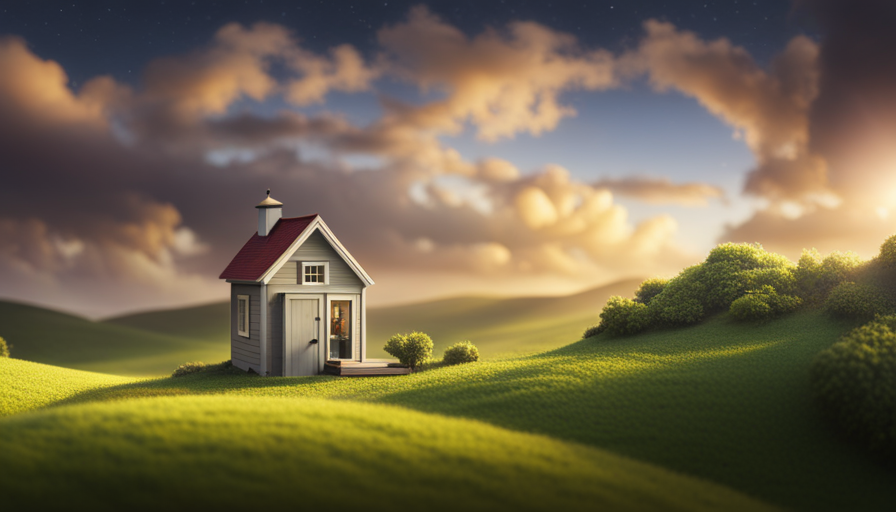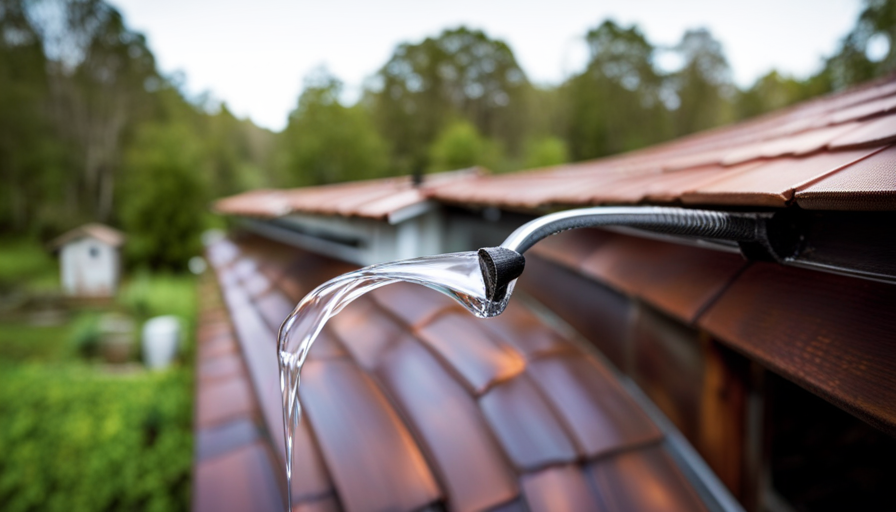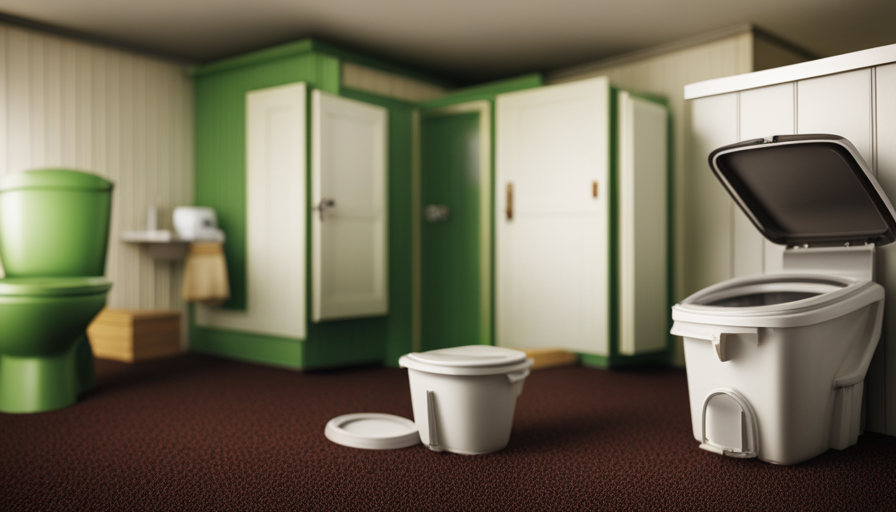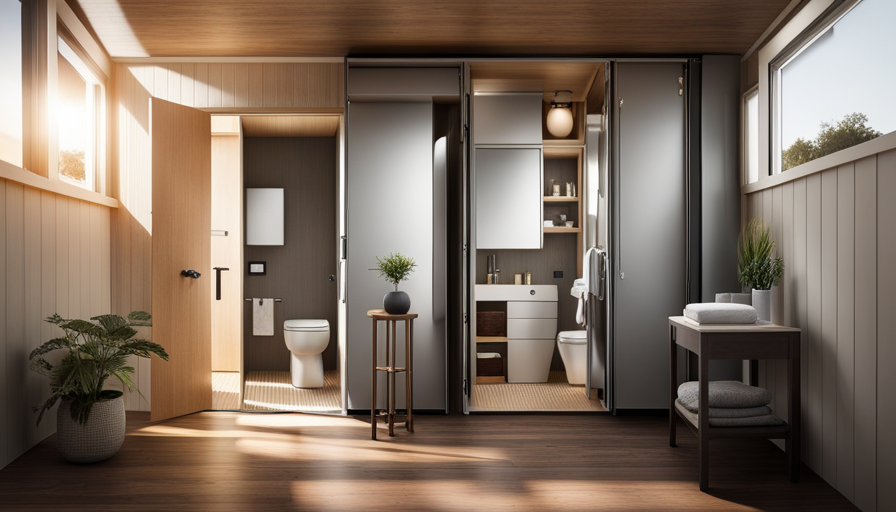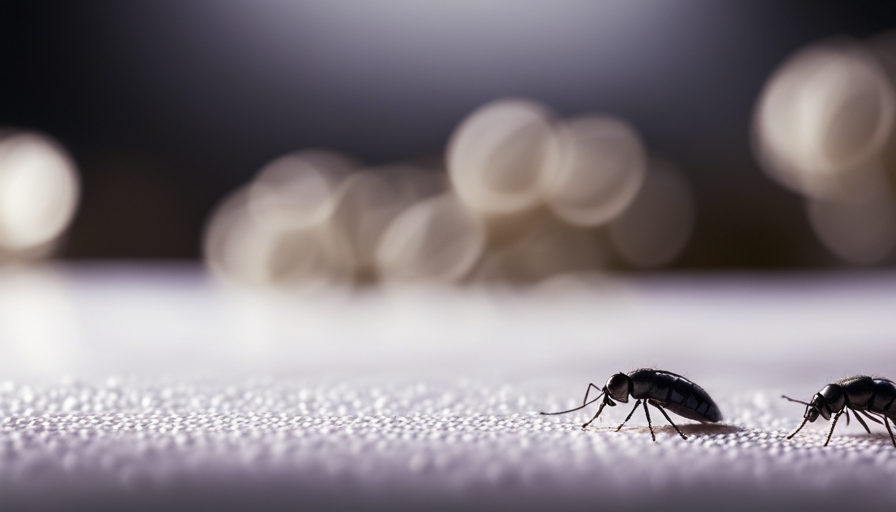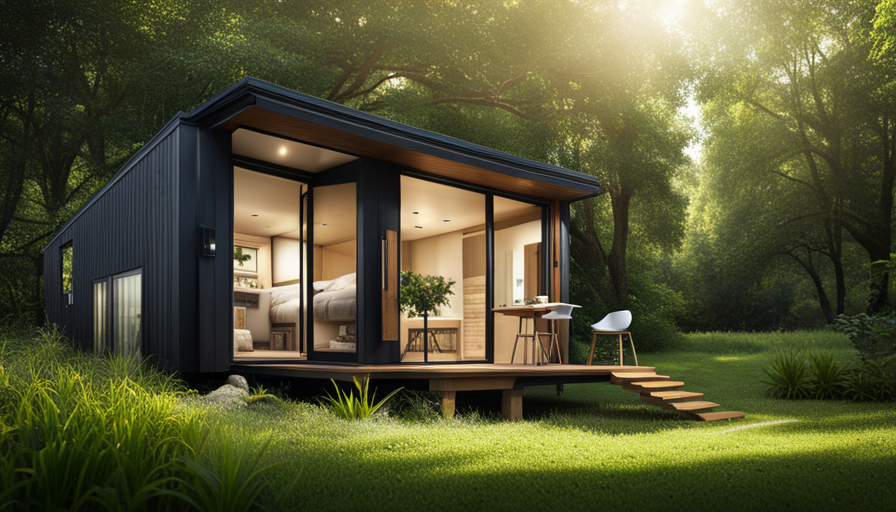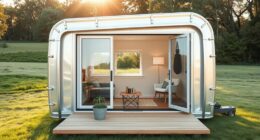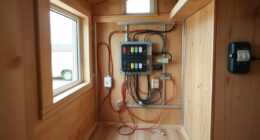Explore the enchanting world of tiny homes, where each small dwelling embodies the beauty of minimalist living. It’s a symphony of clever design, showcasing a perfect balance of creativity and innovation. These compact living spaces represent the essence of elegant simplicity, with every detail carefully crafted for maximum functionality.
Picture a tiny house, a charming dwelling that stands proudly on its wheels, resembling a miniature version of a traditional home. Its exterior is adorned with sleek lines and cleverly placed windows that invite natural light to dance within. Inside, you’ll find a meticulously designed layout that seamlessly blends form and function.
The kitchen and dining area, cleverly tucked away, boast efficient appliances and clever storage solutions. The living and sleeping areas cocoon you in comfort, while the bathroom and storage spaces are ingeniously integrated.
With their eco-friendly design and sustainable features, these tiny houses are a testament to our commitment to a greener future. So come, join me on a journey as we delve into the mesmerizing world of tiny houses and discover the enchanting possibilities of minimalistic living.
Key Takeaways
- Tiny houses are compact dwellings that prioritize space and functionality.
- The exterior design of a tiny house can be customized with unique materials and a color scheme to create a modern or personalized look.
- The interior design of a tiny house maximizes space and creates a warm and inviting atmosphere with compact and multi-functional furniture, clever storage solutions, and efficient fixtures.
- Tiny houses prioritize energy efficiency, sustainability, and personalization, while also offering lower costs and maintenance compared to traditional houses.
Exterior Design of Tiny Houses
When you step outside of your tiny house, you’ll be greeted by a charming exterior design that is sure to make you smile. Tiny houses come in a variety of designs, but one thing they all have in common is their use of unique and innovative materials. From sleek metal panels to rustic wood siding, the exterior of a tiny house can be customized to fit your personal style.
Some popular materials used for tiny house exteriors include cedar, corrugated metal, and even reclaimed materials like barn wood. These materials not only add visual interest but also provide durability and weather resistance.
In addition to the materials, the color scheme of a tiny house can greatly impact its overall aesthetic. Many tiny house owners opt for neutral colors such as white, gray, or beige to create a clean and modern look. Others choose bold and vibrant colors to make a statement and add a pop of personality to their tiny home. Whether you prefer a monochromatic color scheme or a vibrant rainbow of hues, there are endless possibilities for creating a striking exterior design.
As you step inside your tiny house, the interior layout and design continue to impress. [Transition: Now let’s explore the interior layout and design of these cozy homes.]
Interior Layout and Design
Imagine stepping into a cozy abode that surprises you with its cleverly designed interior layout and stylish decor. The interior of a tiny house is all about maximizing space and functionality while still creating a warm and inviting atmosphere. One of the key elements in the interior design of a tiny house is the choice of color scheme. Light and neutral colors are often used to make the space feel larger and more open. These colors also help to create a calming and peaceful ambiance.
When it comes to furniture selection, every piece must serve a purpose and be multi-functional. The furniture in a tiny house is usually compact and designed to fit seamlessly into the available space. Folding tables and chairs, storage ottomans, and built-in benches with hidden storage compartments are just a few examples of the furniture options that can be found in a tiny house.
As we move into the next section about the kitchen and dining area, you’ll find that these same principles of space optimization and clever design continue to be applied.
Kitchen and Dining Area
When it comes to the kitchen and dining area in a tiny house, compact appliances and clever storage solutions are essential. I’ve seen innovative designs that maximize every inch of space, such as foldable countertops and hidden storage compartments.
Additionally, creative dining options are a must in small spaces, and I’ve come across ingenious ideas like multi-purpose furniture that can transform from a dining table to a workspace or even a bed.
Compact appliances and clever storage
In a tiny house, you’ll find compact appliances and clever storage solutions that will astonish you. The key to making the most of limited space is to maximize vertical space and utilize every nook and cranny. Compact appliance options are essential in a tiny kitchen. These include slimline refrigerators, compact dishwashers, and combination microwave ovens. These appliances are designed to fit seamlessly into the limited kitchen space without compromising functionality. Additionally, clever storage solutions play a vital role in keeping the tiny kitchen organized. From pull-out pantry shelves to under-counter storage solutions, every inch is utilized efficiently. To give you a visual representation of these ideas, here is a table showcasing some compact appliances and storage options commonly found in tiny houses:
| Appliance | Description |
|---|---|
| Slimline refrigerator | Narrow design to save space |
| Compact dishwasher | Smaller size for limited kitchen space |
| Combination microwave oven | Combines microwave and oven functionalities for versatility |
| Pull-out pantry shelves | Maximizes storage space while remaining easily accessible |
Now, let’s move on to creative dining options in small spaces.
Creative dining options in small spaces
Surprisingly, even in cramped quarters, dining in tiny spaces can be a delightful experience. With some ingenuity and clever design, unique seating arrangements and multifunctional furniture can transform a small dining area into a versatile space that caters to both dining and other activities. Here are four ways to make the most of your tiny dining area:
-
Foldable tables and chairs: These space-saving pieces can be easily tucked away when not in use, allowing you to maximize the available space.
-
Built-in benches with storage: Utilize the perimeter of your dining area by incorporating benches with hidden storage compartments underneath. This provides additional seating and a place to store dining essentials.
-
Wall-mounted drop-leaf tables: These tables can be folded down when not needed, freeing up valuable floor space. When extended, they provide enough surface area for dining.
-
Convertible dining areas: Explore furniture options that can transform from a dining table into a workstation or entertainment center. This way, you can make the most of your limited space.
Transitioning into the subsequent section about living and sleeping areas, it’s important to maximize every inch of a tiny house to create functional and comfortable living spaces.
Living and Sleeping Areas
Step inside a tiny house and you’ll find a cozy living area with a compact sofa and a foldable table. The living area is designed to maximize space efficiency while still providing comfort. The sofa is carefully chosen to fit perfectly in the limited space, offering a place to relax and unwind after a long day. The foldable table serves multiple purposes, serving as a dining area when needed and then easily stowed away to create more room.
Moving on to the bedroom arrangement, the sleeping area in a tiny house is ingeniously designed to make the most of the available space. A loft bed is a popular choice, with a ladder leading up to it. This not only saves valuable floor space but also creates a sense of privacy and separation from the rest of the living area. Alternatively, some tiny houses have a murphy bed, which can be folded up and hidden away during the day, giving the room a multi-functional purpose.
As we transition into the next section about the bathroom and storage, it’s important to note that every inch of a tiny house is carefully utilized. From hidden storage compartments under the stairs to cleverly designed built-in cabinets, there is no wasted space. The bathroom, although compact, is designed to be functional with a space-saving shower, toilet, and sink. Storage solutions are integrated throughout the house, ensuring that everything has its place and clutter is kept to a minimum.
Bathroom and Storage
When you step into the bathroom of a tiny house, you’ll be amazed by the clever utilization of space and the functional design, making it feel like a sanctuary even in the smallest of areas. The bathroom design in a tiny house is all about maximizing efficiency while still providing all the necessary amenities.
The walls are often lined with waterproof materials like tile or fiberglass, creating a sleek and clean look. The shower is usually a compact, stand-up style with a foldable door to save space. The toilet is often a composting or incinerating type, reducing the need for plumbing and allowing for more flexibility in placement.
Storage solutions are ingeniously integrated into every nook and cranny. You’ll find shelves above the toilet, hooks on the walls for towels, and even hidden compartments under the sink. The vanity is typically small but functional, with a mirror and enough space for toiletries.
Moving from the bathroom to the outdoor spaces and landscaping, you’ll be delighted by the seamless transition as the tiny house extends its charm beyond its walls.
Outdoor Spaces and Landscaping
As you venture into the great outdoors surrounding your tiny abode, prepare to be captivated by the enchanting outdoor spaces and meticulously designed landscaping that seamlessly complement your cozy retreat.
The outdoor seating area beckons you to unwind and bask in the serenity of nature. Picture yourself lounging on a comfortable patio chair, sipping your morning coffee while listening to the soothing sounds of birds chirping and leaves rustling in the breeze.
The garden design, carefully curated with a myriad of vibrant flowers, lush greenery, and aromatic herbs, creates a visual feast for the senses. Imagine strolling through the winding stone pathways, feeling the softness of the grass beneath your feet, and inhaling the fragrant scents that waft through the air.
Every corner of your outdoor oasis is thoughtfully adorned with cascading vines, charming trellises, and quaint garden ornaments that add a touch of whimsy to the scenery. As you take in the beauty of your surroundings, you can’t help but feel a deep sense of tranquility and contentment.
And just as your outdoor space embraces you with its natural allure, so too does your tiny house, with its well-designed lighting and ventilation systems that ensure comfort and harmony in every corner.
Lighting and Ventilation
Immerse yourself in the comforting ambiance of your tiny abode as the carefully curated lighting and ventilation systems create an atmosphere of tranquility and harmony throughout. When it comes to lighting options, tiny houses offer a variety of choices to suit your personal style and needs. From recessed LED lights that provide a sleek and modern look, to pendant lights that add a touch of elegance, there is something for everyone. Additionally, skylights and large windows allow natural light to flood the space, making it feel open and inviting.
In terms of ventilation, tiny houses are equipped with innovative systems to ensure fresh air circulation. Compact yet efficient, ventilation fans can be installed in bathrooms and kitchens to remove odors and prevent moisture build-up. These fans are designed to be whisper-quiet, ensuring a peaceful living environment. Furthermore, tiny houses often incorporate windows with adjustable louvers, allowing you to control the airflow and create a comfortable indoor climate.
To illustrate the various lighting and ventilation options available, the following table provides a visual representation:
| Lighting Options | Ventilation Systems |
|---|---|
| Recessed LED Lights | Ventilation Fans |
| Pendant Lights | Adjustable Louvers |
| Skylights | |
| Large Windows |
As we transition into the next section about energy efficiency and sustainability, it is important to note that lighting and ventilation play a crucial role in creating an eco-friendly and comfortable living space.
Energy Efficiency and Sustainability
When it comes to tiny houses, energy efficiency and sustainability are key considerations. By incorporating passive design principles and renewable energy sources, tiny houses can minimize their environmental impact while maximizing their energy efficiency.
Passive design focuses on utilizing natural resources and optimizing the layout of the house to reduce the need for mechanical heating and cooling systems. This can include features such as well-insulated walls and roofs, strategically placed windows for natural lighting and ventilation, and the use of thermal mass to regulate indoor temperatures.
In terms of renewable energy, tiny houses can harness the power of the sun through solar panels to generate electricity. This clean and sustainable energy source can power the house’s appliances, lighting, and heating systems. Additionally, rainwater harvesting systems can be implemented to collect and reuse water for various purposes, reducing the reliance on traditional water sources.
To make the writing more enjoyable and relatable, here are four items to consider when it comes to energy efficiency and sustainability in tiny houses:
- Solar panels: Harness the power of the sun to generate electricity.
- Insulation: Use high-quality insulation materials to minimize heat loss.
- Efficient appliances: Opt for energy-efficient appliances to reduce electricity consumption.
- Rainwater harvesting: Collect and reuse rainwater for various household needs.
As we delve further into the world of tiny houses, energy efficiency and sustainability are just the beginning. Now, let’s explore how personalization and customization play a crucial role in creating the perfect tiny house.
Personalization and Customization
Imagine stepping into your own tiny house, a space that reflects your unique personality and style, where every nook and cranny has been carefully customized to create a one-of-a-kind living experience. In a tiny house, personalization and customization are key elements that make these homes truly special.
From the moment you enter, you’re greeted by personalized decor that showcases your individual tastes and interests. Whether it’s a vibrant color scheme, wall-mounted artwork, or an eclectic mix of furniture, every detail is a reflection of who you are.
But personalization in a tiny house goes beyond just aesthetics. It also extends to the clever storage solutions that are incorporated throughout the space. With limited square footage, every inch counts, and tiny house owners have become masters at finding innovative ways to maximize storage.
From hidden compartments under stairs to built-in shelving units that utilize vertical space, the possibilities are endless. These unique storage solutions not only help keep the house organized and clutter-free but also add to its charm and functionality.
As we delve into the pros and cons of living in a tiny house, it’s important to consider how personalization and customization can greatly enhance the overall experience.
Pros and Cons of Living in a Tiny House
Step into the world of tiny living and discover the pros and cons that come with it. Living in a tiny house certainly has its perks, but it also comes with its fair share of challenges.
One of the main advantages of living in a tiny house is its sustainability. With a smaller footprint, it requires fewer materials to build and less energy to maintain. This makes it an environmentally-friendly option for those who are conscious of their impact on the planet.
Financial considerations are another aspect to consider when thinking about living in a tiny house. The cost of purchasing or building a tiny house is significantly lower than that of a traditional house. Additionally, the reduced size translates into lower utility bills and maintenance costs. This can be a huge advantage for individuals who’re looking to save money or live a more minimalist lifestyle.
However, it’s important to acknowledge the challenges that come with living in a tiny house. Limited space can be a major obstacle, requiring creative storage solutions and efficient use of every square inch. Additionally, living in close quarters with another person or a family can test one’s patience and privacy.
While tiny houses offer sustainability and financial benefits, they also present challenges such as limited space and potential lifestyle adjustments. It’s essential to carefully consider these pros and cons before embarking on the journey of tiny living.
Frequently Asked Questions
How much does it cost to build a tiny house?
Building a tiny house can be a budget-friendly adventure. On average, costs range from $20,000 to $100,000, depending on size, materials, and location. Allocating funds for construction, utilities, and permits is crucial for a successful project.
Are tiny houses legal in all areas?
Tiny house zoning and regulations vary by location, so it’s important to research local laws. Factors like minimum square footage, foundation type, and permitted uses can influence the legality of tiny houses in different areas.
Can I customize the exterior design of my tiny house?
Yes, you can customize the exterior design of your tiny house. There are various exterior color options available, allowing you to choose a style that suits your taste. You can also add outdoor living space to enhance the functionality of your tiny house.
What are the common challenges of living in a tiny house?
Living in a tiny house presents challenges such as limited storage space, lack of privacy, and adapting to a minimalist lifestyle. However, these can be overcome by utilizing space-saving furniture and clever organizing techniques.
How do tiny houses handle plumbing and wastewater disposal?
Handling plumbing and wastewater disposal in tiny houses can be a real "thrill". We rely on ingenious systems like composting toilets and clever plumbing setups to ensure our humble abodes stay clean and functional. It’s a delicate dance, my friend.
Conclusion
In conclusion, living in a tiny house can be a harmonious dance between functionality and coziness. The compact exterior design elegantly conceals a world of cleverly crafted interior spaces.
The kitchen and dining area become a culinary sanctuary, while the living and sleeping areas transform into a sanctuary for rest and relaxation.
The bathroom and storage solutions efficiently utilize every square inch. In this tiny abode, lighting and ventilation breathe life into the space.
Energy efficiency and sustainability take center stage, while personalization and customization add a touch of individuality.
As with any dwelling, there are pros and cons to consider, but the allure of a tiny house lies in its ability to be a compact haven that embodies the art of living simply and beautifully.
Hi, I’m Emma. I’m the Editor in Chief of Tiny House 43, a blog all about tiny houses. While tree houses are often associated with childhood, they can be the perfect adult retreat. They offer a cozy space to relax and unwind, surrounded by nature. And since they’re typically built on stilts or raised platforms, they offer stunning views that traditional homes simply can’t match. If you’re looking for a unique and romantic getaway, a tree house tiny house might just be the perfect option.
